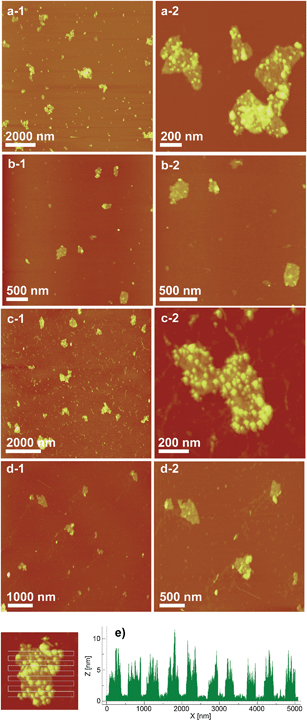
Additions and corrections
Noncovalent DNA decorations of graphene oxide and reduced graphene oxide toward water-soluble metal–carbon hybrid nanostructures via self-assembly
Jinbin Liu, Yulin Li, Yueming Li, Jinghong Li and Zhaoxiang Deng
J. Mater. Chem., 2010, 20, (DOI: 10.1039/b917752c). Amendment published 21st December 2010.
The axes in Fig. 4 are incorrect, the correct Fig. 4 and caption is shown below.

Fig. 4 AFM images of DNA decorated (a, b) GO and (c, d, e) RGO nanosheets after being interacted with 6 nm gold nanoparticles. (a, c, e) d(GT)29SH decorated GO (a) and RGO (c, e) after the assembly of gold nanoparticles; (b, d) control experiments showing that d(GT)29 (no thiol tag) decorated GO (b) and RGO (d) were not able to attach gold nanoparticles; (e) height profile analysis of a RGO nanosheet decorated with 6 nm gold nanoparticles, based on which the height of RGO was found to be about 2 nm, and the diameter (measured as height in AFM) of decorated gold nanoparticles was about 5 nm (See Fig. S19 in ESI† for details). Additional AFM images are given in Fig. S4–S7.†.
The text relating to Fig. 4 should read:
We further relied on atomic force microscopy (AFM) to directly look at the assembled structures. The samples were deposited on Mg2+ treated freshly cleaved mica surfaces and then subjected to AFM imaging. Fig. 4 provides an array of randomly chosen AFM images for different samples, from which gold nanoparticles decorated on graphene oxide and reduced graphene oxide nanosheets were clearly visible (also see Fig. S4 and S6†). Section analysis of an AuNP–DNA–RGO assembly revealed that the RGO nanosheet had a height around 2 nm and the surface-adsorbed particles had typical heights of around 5 nm (close to the 6 nm average diameter of as-prepared individual AuNPs). DNA-free RGO nanosheets were found to have a typical height of 0.9 nm (Fig. S2†). Considering there were unstructured DNA coils (Scheme 1) adsorbed on both sides of a nanosheet, this height increase of 1.1 nm for DNA coated RGO was reasonable. Besides, the measured thicknesses of DNA-free RGO and GO (see Fig. S2–S3†) probably meant that only a single atomic layer was included in a nanosheet.
The Royal Society of Chemistry apologises for these errors and any consequent inconvenience to authors and readers.
Back to article